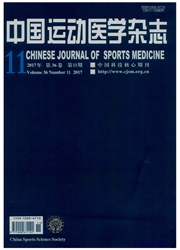

 中文摘要:
中文摘要:
目的:探讨力竭运动影响丘脑底核(STN)神经元电活动改变的可能机制。方法:雄性Wistar大鼠随机分为安静对照组(CG)、力竭即刻组(FG)、恢复90min组(RG)和受体拮抗剂干预组、人工脑脊液对照组,每组均为6只,分别用于免疫组化和干预实验。采用递增负荷进行一次性力竭跑台运动。采用免疫组化技术对一次性力竭运动前、后及恢复过程中大鼠STNmGluR5及GABA-ARα1表达进行观察;并通过STN微量注射mGluR5拮抗剂(MPEP),观察大鼠一次性力竭运动过程中皮层兴奋性及运动能力的变化。结果:力竭即刻组大鼠与安静对照组相比STNmGluR5、GABA-ARα1表达水平差异不显著,恢复90min组大鼠STNmGluR5表达显著高于安静对照组,而GABA-ARα1表达无显著改变。MPEP干预组大鼠与人工脑脊液对照组相比ECoG重心频率曲线的第一波谷出现时间推迟约30min,且运动至力竭的时间明显延长。结论:运动引起STNmGluR5表达改变是导致大鼠STN神经元电活动改变的因素之一;MPEP具有抑制大鼠STN神经元电活动的过分增强并改善运动能力的作用。
 英文摘要:
英文摘要:
Objective To investigate the possible mechanism of exhausting exercise affecting activity of STN. Methods Male Wistar rats were divided into control group(CG),fatigue group(FG),recovering group(RG),MPEP group and ACSF group. Immunohistochemistry and MPEP intervention were used in the study. Rats were running on a rodent treadmill with an incremental load until exhaustion. We observed the mGluR5 and GABA-ARα1 expressions in rats’STN at rest,immediately after exercise and 90min after exercise. We also observed the changes in behavior and motor cortex activity through micro-injection of antagon MPEP during the process of exhausting exercise. Results As compared with CG,mGluR5 and GABA-ARα1 expression level in FG changed insignificantly. mGluR5 in RG increased significantly,while GABA-ARα1 in RG changed insignificantly. Comparing to ACSF control group, emergence of the first gravity frequency trough in MPEP group was delayed about 30min,and exercise duration significantly prolonged. Conclusion Exercise-induced change in expression of mGluR5 in STN is one of the factors that resulted in alteration of electrical activity;and MPEP intervention seems to improve exercise capacity through depressing the STN activity.
 同期刊论文项目
同期刊论文项目
 同项目期刊论文
同项目期刊论文
 期刊信息
期刊信息
